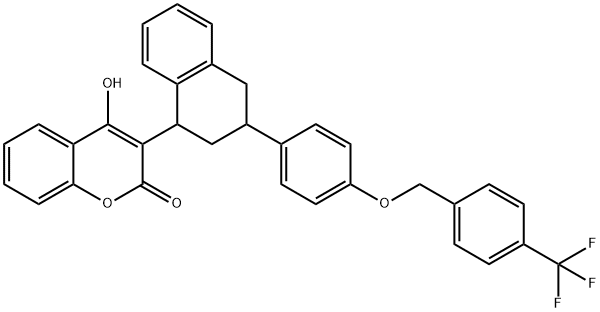
ФЛОКУМАФЕН
- английское имяFlocoumafen
- CAS №90035-08-8
- CBNumberCB6671271
- ФормулаC33H25F3O4
- мольный вес542.54
- EINECS421-960-0
- номер MDLMFCD01662724
- файл Mol90035-08-8.mol
| Температура плавления | 181 °C |
| Температура кипения | 672.4±55.0 °C(Predicted) |
| плотность | 1.2 g/cm3 |
| давление пара | 1.33 x l0-10 Pa (25 °C) |
| Fp | 23 °C |
| растворимость | Chloroform (Slightly), Methanol (Slightly) |
| форма | Solid |
| Растворимость в воде | 1.1 mg l-1 |
| пка | 4.50±1.00(Predicted) |
| цвет | White to off-white |
| ИнЧИКей | KKBGNYHHEIAGOH-UHFFFAOYSA-N |
| FDA UNII | 2Z80062XQ4 |
| Система регистрации веществ EPA | 2H-1-Benzopyran-2-one, 4-hydroxy-3-[1,2,3,4-tetrahydro-3-[4-[[4-(trifluoromethyl)phenyl]methoxy]phenyl]-1-naphthalenyl]- (90035-08-8) |
| UNSPSC Code | 41116107 |
| NACRES | NA.24 |
| Коды опасности | T+,N |
| Заявления о рисках | 26/27/28-48/23/24/25-50/53 |
| Заявления о безопасности | 28-36/37/39-45-60-61 |
| РИДАДР | 3027 |
| WGK Германия | 3 |
| RTECS | DJ3100300 |
| Класс опасности | 6.1(a) |
| Группа упаковки | I |
| Банк данных об опасных веществах | 90035-08-8(Hazardous Substances Data) |
| Токсичность | LD50 in rats, mice, rabbits (mg/kg): 0.25, 0.8, 0.2 orally (Bowler) |
рисовальное письмо(GHS)
-
рисовальное письмо(GHS)



-
сигнальный язык
опасность
-
вредная бумага
H372:Поражает органы в результате многократного или продолжительного воздействия.
H360D:Может отрицательно повлиять на неродившегося ребенка.
H300+H310+H330:Смертельно при проглатывании, при контакте с кожей или при вдыхании.
H410:Чрезвычайно токсично для водных организмов с долгосрочными последствиями.
-
оператор предупредительных мер
P202:Перед использованием ознакомиться с инструкциями по технике безопасности.
P260:Не вдыхать газ/ пары/ пыль/ аэрозоли/ дым/ туман.
P273:Избегать попадания в окружающую среду.
P280:Использовать перчатки/ средства защиты глаз/ лица.
P302+P352+P310:ПРИ ПОПАДАНИИ НА КОЖУ: Промыть большим количеством воды. Немедленно обратиться за медицинской помощью.
P304+P340+P310:ПРИ ВДЫХАНИИ: Свежий воздух, покой. Немедленно обратиться за медицинской помощью.
ФЛОКУМАФЕН химические свойства, назначение, производство
Использование
Flocoumafen is a second-generation anti-coagulant used as a rodenticide. It has a very high toxicity and is restricted to indoor use and sewers (in the United Kingdom). This restriction is mainly due to the increased risk to non-target species. Studies have shown that rodents resistant to first-generation anti-coagulants can be adequately controlled with flocoumafen. The chemical substance is off-white solid, does not mix well with water (1.1 mg/L), and is sparingly soluble in acetone, ethanol, xylene, and octanol. Flocoumafen is stable to hydrolysis. Because of the acute toxicity of flocoumafen and its intended use as a rodenticide, chronic toxicity studies have not been reported. However, flocoumafen is known to cause adverse health effects and abnormal prothrombin.Метаболический путь
Flocoumafen exists as cis and trans isomers (Scheme 1). The tetralin ring adopts its most stable conformation in each case and the two forms have very similar shapes. Both are active rodenticides. The fate of flocoumafen in soils and plants has not been studied in detail because the compound is usually used as a pelleted bait or in a wax block. This limits its dissipation in the environment. Studies in animals and birds have been conducted as part of the assessment of safety and to investigate mode of action. Metabolism is slow in the rat and rapid in Japanese quail but this difference should be interpreted with care because of the 100-fold difference in dose used (see also Overview).Деградация
Flocoumafen is a stable compound; no detectable degradation occurs at 50 °C at pH 7-9 over 4 weeks.